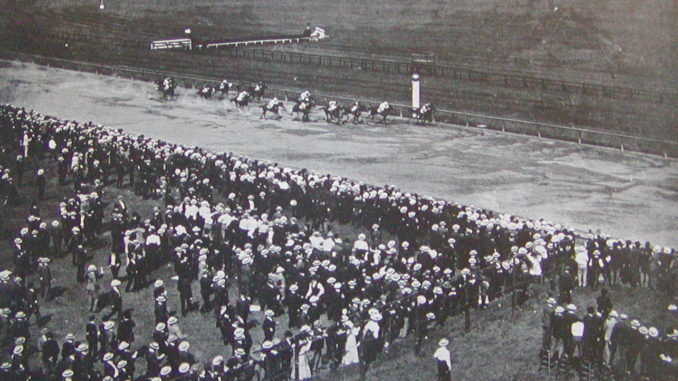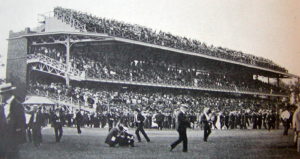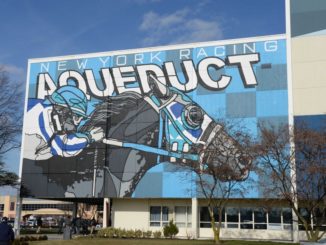
by TERESA GENARO
The child, sitting down with the old man close behind…had been thinking how strange it was that horses who were such fine honest creatures should seem to make vagabonds of all the men they drew about them…
Charles Dickens, The Old Curiosity Shop
Dickens couldn’t possibly have been thinking of Correction when he wrote those words—the novel was published in 1841, and she was born four decades later—but the filly did seem to have an uncanny ability to attract to herself something of an unsavory sort.
Foaled in 1888, Correction (Himyar – Mannie Gray) was an older full sister to Domino, who won the Withers, the Sheepshead Bay, the Matron, and the Futurity, among others, and who was a member of the inaugural class of inductees into the U.S Thoroughbred Racing Hall of Fame.
His sister’s career wasn’t quite so illustrious, nor as well-recorded. She was owned by John A. Morris, the owner of the Morris Park racetrack in what is now the Bronx, and his son Alfred, and while her racing career is well documented in the daily pages of The New York Times, not only is her name absent from most histories of the turf, but she doesn’t even have a Wikipedia page, perhaps the most damning contemporary indicator of cultural and historical irrelevance.
Correction does have a couple of stakes wins to her credit—at two in the Clover Stakes and at six in the Toboggan Slide—and, according to Pedigree Query, she made 122 starts, winning 38 of them. But she seems to have gotten the most ink for being the subject of no little bit of racing controversy, and on more than one occasion.
In 1893, a New York Times writer—no bylines back in those days, and the reporters spoke much more freely than today’s circumspect press–used his race report to express, with biting sarcasm, the confident opinion that a certain Johnny Lambley, in conjunction with racing bigwig Mike Dwyer—the man for whom the race is named, and a big-time gambler–pulled his horse so that Dwyer could cash a ticket on one of his own horse’s rivals:
Johnny Lambley seems to have into training as a rival to the two strong-armed men that are now on exhibition at a couple of the roof-garden shows in this city, Sandow and Sampson. He took his exercise while riding Stonenell in the first race at the Sheepshead Bay track yesterday, and not a man who saw the performance but will now be willing to back him against either of the imported strong men.
Mr. Dwyer…backed [Correction] heavily to beat his own horse, Stonenell, though the latter is better at any weight and any distance, if he is allowed to run honestly, than a whole breeding farm of Corrections.
“A Very Queer-Looking Race,” New York Times, June 20, 1893
The writer notes that the betting public made Stonenell the favorite, “…supposing…that they would get an honest run for their money, and that Stonenell would be allowed to beat Correction if he could…People knew that if the race was (sic) honestly run, it would be but child’s play for Stonenell to beat Correction.”
The author enumerates the suspicious factors in the race: Dwyer had bet and lost $25,000 on Correction in her last race; Correction was 0 for 5 at the Sheepshead Bay track, while Stonenell had won over it; Correction had never won beyond five furlongs, but on this day, she ran five and a half “in slow time [1:08] over a fast track.”

One spectator is said to have remarked at the start of the race, “So Lambley is taking the overland route home, is he? And Mike Dwyer is backing Correction…” The reporter pointed out that “[the spectator] voiced the feeling of all close observers of the race. That Lambley was showing how strong his biceps were was thoroughly apparent when the horses came into the stretch.”
He went on, “Correction won under the circumstances. [Mike] Dwyer got square for his losses on the mare at the Morris Park. The public got it where the chicken got the axe, except those who were shrewd enough to hedge their bets when they found out what Mr. Dwyer was doing. Lambley got off without punishment.”
This bit of alleged chicanery was not the first time that Correction found herself at the center of suspicious circumstances. Two years earlier, her connections had been accused of running her without intending for her to win.
Following a win at the Sheepshead Bay track in August of 1891, the stewards questioned her trainer, R.W. Walden (a 1970 Hall of Fame inductee), about what they saw as the filly’s rather surprising reversal of form. Walden told them that her improvement over her last race, earlier that month at Morris Park, was due to a change in the length of the race—when she was beaten at Morris Park she ran at seven furlongs, but in the Sheepshead race, she won at five and a half (contrary to what our 1893 reporter asserted). The earlier race had been her first after an illness, and she ran out of gas at that distance because she wasn’t fit.
“That was Mr. Walden’s explanation,” read the report in the Times, “and, as the Stewards [at the Sheepshead Bay track] had no jurisdiction as to what was done over the Morris Park track they accepted the explanation which was in effect that Correction had been run for work at Morris Park and that the work she then had had keyed her up for the race she won. As there is no punishment in the rules for trainers who run their horses for work in races, the board could do nothing, particularly as the offense was committed on a track over which they have no jurisdiction. If any punishment was to be meted out to Mr. Walden for running the filly for work they decided that the Board of Control must be the party to act, and there the case was left. The Board has not acted, and will probably do nothing.” (“Correction’s Running Inquired Into,” September 1, 1891)
Among the many great things about these old articles is the recognition that the good old days of racing of which are so wistfully spoken may indeed be old, but not really so good. Horses were medicated, trainers and jockeys cheated, and various organizations, as seen in this incident, squabbled and competed for authority, and were reproached for incompetence or impotence, and sometimes both.
The Correction was first run in 1940, at the old Jamaica track in Queens, which found her worthy to honor with an eponymous race. Fortunately, Correction, that “fine, honest creature,” or at least her legacy, had at least one person who, unlike a rival owner and her own connections, was not a vagabond.


